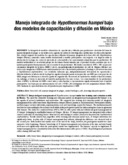| dc.contributor.author | Jarquín Gálvez, Ramón | |
| dc.contributor.author | Barrera, Juan F. | |
| dc.contributor.author | García Barrios, Luis | |
| dc.contributor.author | Guharay, Falguni | |
| dc.contributor.author | Jiménez Sánchez, Leobardo | |
| dc.date.accessioned | 2015-03-19T21:52:23Z | |
| dc.date.available | 2015-03-19T21:52:23Z | |
| dc.date.issued | 2006 | |
| dc.identifier | 471596 | es_ES |
| dc.identifier.issn | 1659-0082 | es_ES |
| dc.identifier.uri | https://repositorio.catie.ac.cr/handle/11554/6553 | |
| dc.description.abstract | La búsqueda de modelos alternativos de capacitación y difusión para productores alrededor del tema de manejo integrado de plagas se encuentra en las agendas de centros de investigación e instituciones de educación superior. Este estudio comparó dos modelos de capacitación y difusión del manejo integrado de la broca del café Hypothenemus hampei (Ferrari), conocidos como modelo institucional y modelo participativo, con respecto a su impacto sobre la infestación de la plaga, los costos de ejecución de cada modelo y los conocimientos adquiridos por los productores. El modelo institucional se caracterizó porque las decisiones fueron tomadas por el personal técnico, mientras que en el modelo participativo fueron tomadas con el acuerdo de los productores. El estudio se realizó de 1998 a 2001 en parcelas con manejo integrado de la broca (MIB) y sin él, con participación de productores de café de Chiapas, México. Las
tácticas que integraron el MIB fueron control manual (recolección de frutos perforados) y biológico (Beauveria bassiana y Cephalonomia stephanoderis). Los resultados indicaron que, independientemente del modelo de capacitación y difusión utilizado, la infestación de la plaga fue significativamente menor en las parcelas con MIB que en las parcelas sin MIB, aunque esta diferencia se observó a partir del segundo año. El costo de los modelos fue similar al final del estudio; sin embargo, al inicio la ejecución del modelo participativo fue más costosa. Los conocimientos de los productores sobre el MIB y la difusión del MIB a nivel intra y extra familiar se incrementaron significativamente bajo el modelo participativo. Los bajos precios internacionales del café (<US$ 1,20 el kilogramo del café pergamino) durante 2000 y 2001 limitaron la capacidad financiera del productor para implementar el MIB. | es_ES |
| dc.description.abstract | The quest for alternative training and extension models on integrated pest management for farmers is on the agenda of research institutions and universities. We compared two training and extension models of integrated management of the coffee berry borer Hypothenemus hampei (Ferrari), known as Institutional and Participatory Models, and their impact on borer infestation, implementation costs and knowledge acquired by farmers. The institutional model involved decision-making by the technical staff whilst in the participative model decision-making was done in agreement with farmers. The study was conducted from 1998 to 2001 in coffee plots with and without integrated management of H. hampei belonging to smallholder farmers of Chiapas, Mexico. H. hampei management was integrated with cultural control (collection of remaining berries after harvest) and biological control (Beauveria bassiana and Cephalonomia stephanoderis). Results showed that, regardless of the training and extension model used, H. hampei infestation was significantly lower in plots with H. hampei management than without, although the difference was observed only in the second year. Both models had similar costs at the end of the study; however, the participative model was more
expensive at the beginning. Farmers’ knowledge of H. hampei management and extension at the intra and inter family level increased significantly when the participatory model was implemented. The farmers’ capacity to implement H. hampei management was considerably reduced by low international coffee prices (<US$ 1.20 per kilogram of parchment coffee) during 2000 and 2001. | en_EN |
| dc.format.mimetype | pdf | |
| dc.language.iso | es | es |
| dc.publisher | Centro Agronómico Tropical de Investigación y Enseñanza (CATIE), Turrialba (Costa Rica) | es_ES |
| dc.relation.ispartof | Manejo Integrado de Plagas y Agroecología Número 78 (Agosto 2006) | |
| dc.rights.uri | https://creativecommons.org/licenses/by-nc-nd/4.0/ | |
| dc.subject | HYPOTHENEMUS HAMPEI | es_ES |
| dc.subject | COFFEA ARABICA | es_ES |
| dc.subject | BEAUVERIA BASSIANA | es_ES |
| dc.subject | LUCHA INTEGRADA | es_ES |
| dc.subject | CONTROL DE INSECTOS | es_ES |
| dc.subject | CONTROL BIOLOGICO | es_ES |
| dc.subject | AGRICULTORES | es_ES |
| dc.subject | CAPACITACION | es_ES |
| dc.subject | COSTOS | es_ES |
| dc.subject | EXPERIMENTACION EN CAMPO | es_ES |
| dc.subject | MEXICO | es_ES |
| dc.title | Manejo integrado de Hypothenemus hampei bajo dos modelos de capacitación y difusión en México | es_ES |
| dc.title.alternative | Integrated pest management of Hypothenemus hampei under two training and extention models in Mexico | es_ES |
| dc.type | Artículo | es_ES |
| dc.journal.issueNumber | 78 | |
| dc.journal.pages | 36-45 | |



